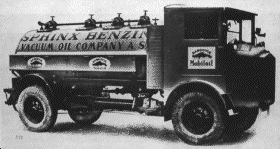

In about 1919 trucks under the marque Tatra begun appearing in the newly created country of Czechoslovakia. The company manufacturing these trucks, situated in the Moravian town of Koprivnice (of which the Germanic name is Nesselsdorf), was called Koprivnicka Vozovka a.s. (Koprivnice Wagon Works) and would become Tatra some years later. Prior to this it had actually been called Nesselsdorfer Wagenbau Fabrik (Nesselsdorf Wagon Works). The history of this manufacturer streches back to the 1850s under various names and it has produced such vehicles as the mentioned trucks (built since the 1890s), automobiles (see the unofficial TATRA pages), carriages, wagons, and railway coaches. The firm is actually most famous for its fantastic aerodynamic sedans with rear-mounted engines but trucks have accounted for a major portion of its output since the 1950s.
The Tatra name comes from the Tatra High Mountains, some of the higher peaks of the Carpathian mountain range. One particular day on a road from the settlement of Lomnica to Strba (Szczyrbsk in Polish) in the Tatras (check the map in the The Tatra Mountains Virtual Tourist for the location) a very successful test, in 1919 or so, of a Nesselsdorfer vehicle (sporting experimental 4-wheel brakes) occurred. This involved passing a sleigh on the snow-covered road and suprising its occupants as to how an automobile or truck could cope in such conditions, prompting a statement to the effect of "This is a car for the Tatras!". And the rest is, as they say, history.
 No doubt one of the greatest contributors to the manufacturer was the
Austrian engineer Hans Ledwinka, who returned in 1921 for good after having
left it for the Austrian Styer in 1916 due to a disagreement with the
management. His return as chief engineer (until the 1930s or so) signalled the emergence of the company as a maker of technically significant and advanced trucks capable of operating in very rough conditions.
No doubt one of the greatest contributors to the manufacturer was the
Austrian engineer Hans Ledwinka, who returned in 1921 for good after having
left it for the Austrian Styer in 1916 due to a disagreement with the
management. His return as chief engineer (until the 1930s or so) signalled the emergence of the company as a maker of technically significant and advanced trucks capable of operating in very rough conditions.
In 1925 appeared the first truck designed as a Tatra from the outset, the ones prior to it started life as Nesselsdorfers and were later renamed (the first to be happend to be a truck). The design of this truck, called the T13, was largely based on concepts that Hans Ledwinka had successfully applied to Tatra automobiles since the T11 of 1923. It featured an independent rear suspension using swing axles and a torsionally rigid central back-bone chassis construction (the drive-shaft ran inside a central tube to which components were attached), which offerred several advantages over more typically used design concepts in trucks. The enclosed drive shaft (within the central tube) is shielded from dirt (of which there may be a lot in, for instance, construction sites) and has a low chance of being damaged, while the rugged central back-bone chassis can tolerate heavy loads and withstand extensive use. The jointless swinging half-axle suspension, being independent and allowing a high range of wheel movement, protected the load (and driver) from unevenness of the road surface and permitted the truck to operate in rough terrain and harsh environments. The system would see a lot of refinement and improvement in its design in the larger Tatra trucks of higher load capacity and, in some cases, of multiple axle construction which would follow the T13.
 a T13
a T13The T13 was powered by an air-cooled 1056cc 2-cylinder OHV (most truck engines in Tatra's history have been OHV) engine of 12bhp output. Air-cooled engines have been extensively employed in Tatra trucks over the years due to several advantages, including greater reliability in severe temperatures.
Various body types were available for the T13, which sported a distinctive clean and rounded nose identical to the one found on Tatra passenger automobiles of the 1920s. In the years from 1925 to 1933 production of the T13, with its 1 ton carrying capacity, totalled 762.
 a T26/30
a T26/30 T23 tanker and bus
T23 tanker and bus
